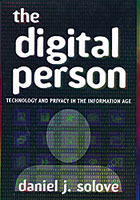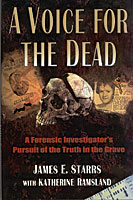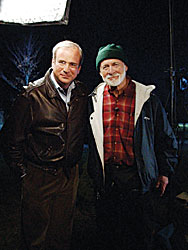Faculty Bookshelf
Digital Dossiers
Sharing information, conducting business,
and communicating via the Internet have made many aspects
of life increasingly convenient. Daniel J. Solove, associate
professor of law and author of The Digital Person:
Technology and Privacy in the Information Age (New
York University Press, 2004), says that convenience comes
at a price.
 Every
time an individual surfs the Internet, databases create
profiles of purchases, activities, interests, and preferences—“digital
dossiers” as Solove calls them—that are used
for credit checks, marketing strategies, and personal
investigations. While information gathering does have
its purposes, Solove explains why these profiles pose
a threat to personal privacy and security and says they
open the door to identity theft. Since Sept. 11, 2001,
Solove says the government has tapped into stores of information
collected by businesses and used it to profile individuals
for criminal or terrorist activity—practices he
says have “Orwellian and Kafkaesque dangers.”
Every
time an individual surfs the Internet, databases create
profiles of purchases, activities, interests, and preferences—“digital
dossiers” as Solove calls them—that are used
for credit checks, marketing strategies, and personal
investigations. While information gathering does have
its purposes, Solove explains why these profiles pose
a threat to personal privacy and security and says they
open the door to identity theft. Since Sept. 11, 2001,
Solove says the government has tapped into stores of information
collected by businesses and used it to profile individuals
for criminal or terrorist activity—practices he
says have “Orwellian and Kafkaesque dangers.”
“The Digital Person is a far-reaching
examination of how digital dossiers are shaping our lives.
Solove has persuasively reconceptualized privacy for the
digital age,” says Brooklyn Law School professor
Paul Schwartz.
From a legal perspective, Solove explores
how current practices match up with the Fourth Amendment
and outlines how current laws fail to keep up with the
technological pace. Solove says increased public awareness
and involvement could curtail the problems involved with
information gathering and could help bring about change—change
that cannot be achieved through individual lawsuits, he
says, but rather through implementing a regulatory system
such as the FDA or the EPA. Harmony between the conveniences
and concerns brought about by Internet communications
can be achieved with reform, Solove says. It’s a
matter of “restructuring the architecture.”
Uncovering the Buried Truth
“The evil that men do lives
after them, The good is oft interred in their bones.”
Professor James E. Starrs borrows Shakespeare’s
lines from Julius Caesar to illustrate his interest
in solving cold cases—some of them hundreds of years
old—in A Voice for the Dead: A Forensic Investigator’s
Pursuit of the Truth in the Grave (Putnam, 2005).
Written with Katherine Ramsland, the book explores several
cases that Starrs helped to solve by examining bodies
long in the grave using technology and forensic science
practices.
 A
professor of forensic sciences and a research professor
of law, Starrs describes the cases from historical, field,
and legal perspectives. “Utilizing modern-day forensic
scientific techniques and top-flight experts, and applying
his vast legal experiences and intellectual brilliance,
Starrs has made significant and unique contributions to
our criminal justice system,” says Cyril H. Wecht,
a professor at the University of Pittsburgh and coroner
of Alleghany County in Pennsylvania. “A Voice for
the Dead is a fascinating real-life discussion of exhumation
autopsies that makes fictional television programs seem
like fairy tales for children.”
A
professor of forensic sciences and a research professor
of law, Starrs describes the cases from historical, field,
and legal perspectives. “Utilizing modern-day forensic
scientific techniques and top-flight experts, and applying
his vast legal experiences and intellectual brilliance,
Starrs has made significant and unique contributions to
our criminal justice system,” says Cyril H. Wecht,
a professor at the University of Pittsburgh and coroner
of Alleghany County in Pennsylvania. “A Voice for
the Dead is a fascinating real-life discussion of exhumation
autopsies that makes fictional television programs seem
like fairy tales for children.”
The exhumations he recounts include
the case of Alfred Packer, a Colorado prospector accused
of cannibalism in the 1870s; the body believed to be that
of Jesse James; and Mary Sullivan, an alleged victim of
Albert DeSalvo, a suspect in the Boston Strangler cases
of the 1960s.
While the scandalous nature of
the lives and deaths of these and other individuals lend
drama to the book, the exhumations themselves spark legal
and moral debate. Starrs chronicles the issues raised
by the government and the descendants of the deceased
and how he justifies disturbing their final rest. Starrs
seeks to balance respect for the dead with the truth for
the living—as he writes, “the lawyer in me
says they deserve their day in court.”
|

|
James
Starrs published A Voice for the Dead: A Forensic
Investigator’s Pursuit of the Truth in the
Grave (Putnam, 2005). Written with Katherine
Ramsland, the book explores several cases that
Starrs helped to solve by examining bodies long
in the grave using technology and forensic science
practices. On May 7, Starrs’ expertise and
techniques were highlighted in a 48 Hours
special segment, “Secrets from the Grave.”
The segment explored the mysterious death of a
Texas man.
|